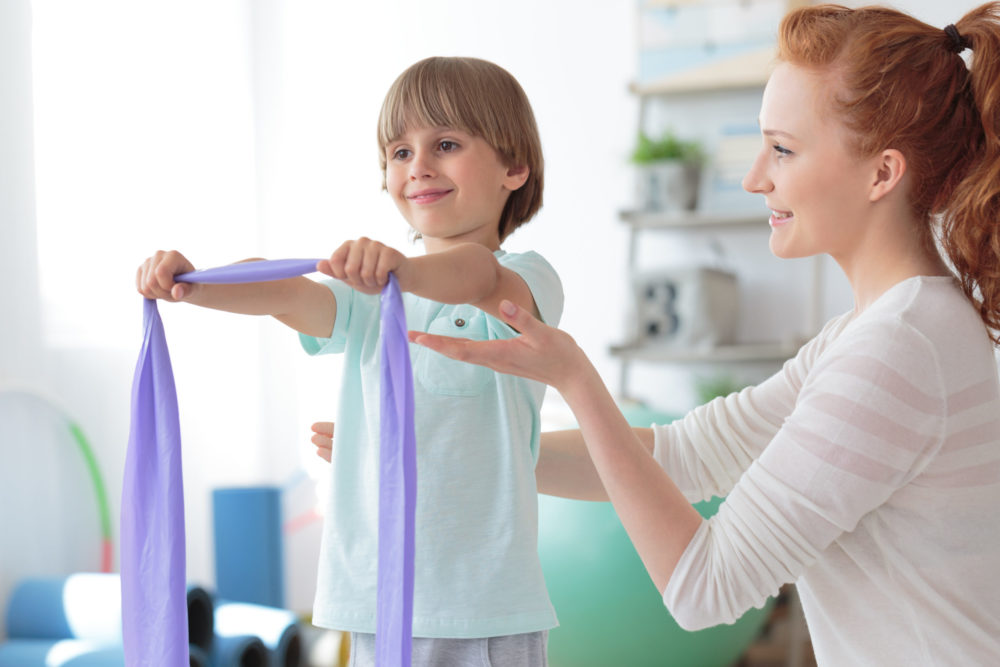When you normally think of exercise, you probably start thinking of treadmills, weights, sets/reps, and maybe even fatigue! When it comes to occupational therapy exercises, especially with pediatric clients, we have to take a different approach.
Just like with adult occupational therapy, pediatric occupational therapy can focus on strengthening, endurance, motor planning, and overall coordination for independence in age-appropriate daily tasks.
What is Pediatric Occupational Therapy Used For?
There are a variety of reasons families turn to pediatric occupational therapy for their children. It has the ability to make daily tasks much easier, such as:
- Dressing
- Bathing
- Toileting
- Self-feeding
Higher-level skills and grasp patterns, including:
- Handwriting
- Drawing
- Coloring
- Scissor skills
Many children struggle with age-appropriate grasp patterns, scissor skills, and writing letters and numbers, all of which can be affected by weakness in the trunk, upper body, arms, and hands.
A phrase often used to describe this is, proximal stability before distal mobility. What that means is a child must have proper coordination, muscle strength, and endurance in their belly and arm muscles before they can have coordinated smooth movements and skills with their hands and fingertips.
For example, if we were treating an adult for upper body weakness, we might have them complete a variety of standard exercises, including the arm bike for 10 minutes for endurance, working with theraputty for 5 minutes for strengthening, followed by a range of motion exercises with a TheraBand and they would complete these exercises with no complaints.
Now if you asked a child with upper body weakness to complete these same tasks, they are going to lose interest fast and may become uncooperative with these everyday activities. We have to get creative with these exercises and make them fun and appealing for the pediatric patient to complete.
Pediatric Occupational Therapy Exercises
The first thing to note is that they are often confused, but occupational therapy and physical therapy are very different. Occupational therapy uses physical activity to improve independence in daily life. One of our favorite ways to incorporate physical activity for our kids is in our sensory-motor gym with an obstacle course!
We set up various obstacles each week that focus on
- Upper body strengthening
- Trunk and core strengthening
- Endurance
- Coordination
- Fine motor activity
- Movement
- Balance
We have our kids complete the obstacle course 3-5 times in the beginning, middle, or end of our sessions depending on what each child needs or requires.
For example, we may start by having a child jump 20 times on the mini trampoline for endurance and coordination then have the child pick up a beanbag and walk along a balance beam and drop off in a bucket for motor planning and balance, followed by drawing a picture on our dry erase board on the wall for upper body strengthening, then run/climb up our incline side and jump/crash onto the crash pad for coordination and strength.
Sounds fun, right? Without evening realizing it, we just incorporated 5-10 skills for any child into a fun, motivating activity that they want to do over and over again!
Now, you might be thinking, I have none of that equipment at my house or I have no room for any of that stuff! No problem, an obstacle course is something that can be easily recreated in your living room or backyard and can be modified for size, space, and material available. The following are great at-home examples:
Couch Cushions/Pillows
This method helps with balance, coordination, upper body strengthening, core strengthening, & motor planning. To do it, follow these steps:
- Scatter pillows or cushions on the floor. Have the ground become “Hot Lava” and have your child jump from pillow to pillow to stay safe. Bonus challenge: Mom/Dad/sibling becomes a “lava monster” or dragon and attempts to follow the child.
- Prop pillows against each other or against other furniture to create a tunnel or bridge for your child to army crawl through.
- Take turns with your child and set up a pathway with the pillows/cushions from point A to point B and take turns seeing who can make it the farthest without falling off the pillows.
Hula Hoops/Sidewalk Chalk
This exercise helps with coordination, balance, jumping, and visual-motor skills. To try it, follow the steps below:
- Make a hopscotch pattern
- Place hula hoops in a straight line for the child to run, hop, jump or step into
- Create bigger spaces between each hoop for a more difficult patterns
Animal Walks:
Animal walking can support upper body strengthening, trunk strengthening, coordination, and motor planning.
- Bear walk – walk with your hands and feet on the floor with hips high
- Crab walk – sit on the floor, place your palms on the ground behind you, lift your hips, and crawl on your hands and feet
- Frog jump – hop up and down like a frog
- Donkey kicks – make sure the area around you is CLEAR! Start in a standing position, bend down, keeping feet on the floor, place hands on the floor and kick legs behind you, together or one at a time.
- Cheetah Run – run as fast as you can in place.
- Snake – lay on your belly on the floor and use your arms to wiggle yourself forward
- Create your own Animal walk
Mime Me
This exercise helps with upper body and lower body coordination, visual motor skills, and motor planning/movement. Here are tips on how to do it:
- Partner up with your child or have your child partner with a friend/sibling, chose one child to be the leader first. Have children stand face to face and have the leader change positions (lift left arm or kick out right foot) and have the partner follow those movements. Switch leaders after 5-10 movements
- Bonus challenge: play a fast/slow round, changing positionings rapidly or holding each position for 10-20 seconds.
** Always be cautious of furniture and other stationary objects in your house/backyard when creating obstacle courses and always supervise children while completing any form of exercise. Modifications to increase or decrease the level of difficulty can be made based on the parent/guardian’s decision and knowledge of the child’s skills and abilities. **
Engaging in the Exercises
Lastly, join in! Children love engaging and playing with their parent, guardian, or sibling. The more fun you look like you are having, the more willing your child will be to participate and join in. Physical activity does not have to be boring and redundant; it can be fun and exciting without your child ever catching on that these everyday activities are working on so many different skills!
If you find your child is having a difficult time completing some of these activities for their age-appropriate level, consult with your pediatrician. An occupational therapy referral may be warranted. An occupational therapy evaluation or screening could assist in determining if your child would benefit from skilled occupational therapy services. Pediatric occupational therapists work with a variety of diagnoses and types of developmental disabilities, including but not limited to Autism, Developmental Delay, Down syndrome, hemiplegia, Cerebral Palsy, prematurity, ADHD, and behavioral concerns. Contact us today to learn more!
Article by: Brittany Bosley
Ivy Rehab Physical Therapy, Virginia
Brittany Bosley, OTR/L, CIMI-2 is an Advanced Level Pediatric Occupational Therapist with Southeastern Therapy for Kids – Ivy Rehab in Virginia. She has been working in pediatrics since she graduated from the University of Southern Indiana in 2016 with her Master’s in Occupational Therapy and has been with Ivy Rehab since 2019. She is a Certified Infant Massage Instructor – Level 2 and is trained in the SOS Feeding Approach. She enjoys working with all ages and diagnoses. Brittany and her husband Jon enjoy traveling and trying new restaurants when it is safe and exploring all Virginia has to offer!





